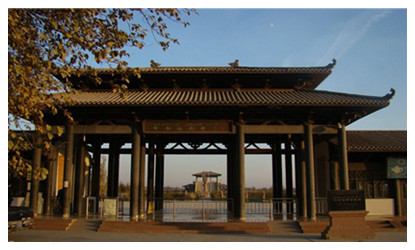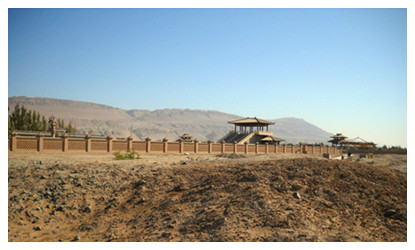Skype: neodalle-travel
Tel: +86 135 7447 2266
E-mail: sales@visitaroundchina.com
 The Astana-Karakhoja Ancient Tombs are part of the Underground Museum of Turpan and the Living Archives of Gaochang. Astana means capital in Uigur; Karakhoja was a Uigur hero who protected his people from a vicious dragon.
The Astana-Karakhoja Ancient Tombs are part of the Underground Museum of Turpan and the Living Archives of Gaochang. Astana means capital in Uigur; Karakhoja was a Uigur hero who protected his people from a vicious dragon.
The tomb complex is 5 km from east to west, and 2 km from north to south. Gravel boundaries separate the tombs by family. The paternal family burial order was strictly followed, similar to the system in the Hexi Corridor (today's Gansu Province), and even in central China. Generally, husband and wife were buried together. In some cases, one man was accompanied by two or three women.
A slope of over 10 meters (32.8 feet) long leads down to the chamber. The chamber is 2 meters (6.6 feet) high with a flat ceiling or a dome. The dead are placed on an earthen or wooden bed in the back of the chamber. They had wood in both hands and wore cotton, linen or silk clothes. Around them are miniature pavilions, carts and horses, parades, musical instruments, chess sets, pens and ink, grapes, melons, dumplings and pancakes -- to be used by the dead in another world. Owing to the arid climate, the relics are very well preserved; dumplings are the same as today's, and the stuffing is as intact as it was when fresh. Murals with vivid pictures of humans, animals, flowers, mountains, and rivers decorate some chambers. A painting of ladies playing chess illustrates the happy life of aristocrats in the early Tang Dynasty (618-907).
Among the more than ten thousand cultural relics excavated are over 2700 books, epitaphs, paintings, clay figurines, and pottery, wood, gold and stone wares, ancient coins, silk and cotton textiles. The time recorded in the books ranges from 273 to 772.
 The tombs are mainly those of the Han people while those of ethnic groups such as the Cheshi, Turki, and Hun are also represented. Tomb structure and placement indicate that while Han people were in the majority in the Gaochang, all nationalities enjoyed equality.
The tombs are mainly those of the Han people while those of ethnic groups such as the Cheshi, Turki, and Hun are also represented. Tomb structure and placement indicate that while Han people were in the majority in the Gaochang, all nationalities enjoyed equality.
It is noteworthy that mummies here compare favorably with Egyptian mummies in both quantity and the quality, providing precious specimens for anthropology, history, medicine, and ethnology. The mummy of the well-known Gaochang General is 1.90 meters tall with well-preserved beard hair and clothes.
Between 1959 and 1975,here had been excavated 13 times, a great number og cultural relics have been unearthed, including Chinese documents, textiles, epitaphs, coins, clay sculptures, pottery, wooden wares, silk-paintings, crops and foods,etc., and total number of them reaches tens thousands.Known as “the Underground Museum ”, the Astana Tombs afford valuable materials for studies on ancient society, economy, politics,culture, religion, art, and cultural exchanges between China and West, and so on. Now it is a listed as a major cultural site under state protection.
Travel Tips
Add:Astana Village, Flame Mountain Township, Turpan, Xinjiang Uygur Autonomous Region
Opening Hours: Currently three chambers are open to the public. For your own safety do not enter the unopened areas.Do not touch the mural inside the chambers.
Entrance Fee: CNY 0
 Ask Questions ?
Ask Questions ?